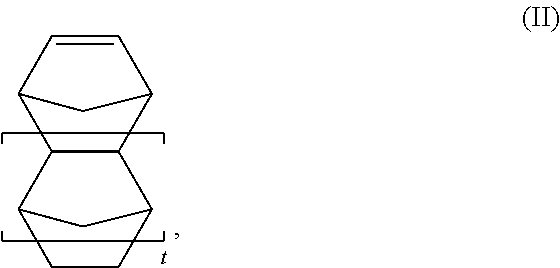Photoresist composition for negative development and pattern forming method using thereof
a technology of composition and composition, applied in the field of photolithography, can solve the problems of becoming ever more difficult to print small features, and achieve the effect of negative developmen
- Summary
- Abstract
- Description
- Claims
- Application Information
AI Technical Summary
Benefits of technology
Problems solved by technology
Method used
Image
Examples
example 1
Resist A Formulation
[0050]A tetrapolymer consisting of 10 mole % McpMA, 40 mole % MAdMA, 15 mole % HAdMA and 35 mole % NLM was dissolved in PGMEA with 30 wt % GBL(γ-butyrolactone), 2 wt % triphenyl-sulfonium 2-bicyclo[2.2.1]hept-7-yl-1,1,2,2-tetrafluoro-ethanesulfonate, 5 wt % (4-cyclohexyl-phenyl)-diphenyl-sulfonium 1,1,2,2,3,3,4,4,4-nonafluoro-butane-1-sulfonate and 0.69 wt % of 2-hydroxymethyl-pyrrolidine-1-carboxylic acid tert-butyl ester (all wt % are relative to the polymer) to make a solution with 4 wt % of solid content. The resulting solution was filtered through a 0.2 μm filter. The resist was spin-coated on a 12″ silicon wafer which consists of 42 nm thickness coating of Dow Chemical AR40 anti-reflective layer on top of LTO (low temperature oxide) and SiCOH (low k dielectric). The resist was post-applying baked (PAB) at 110° C. for 60 seconds and exposed to 193 nm wavelength light on an ASML stepper (0.93 NA, 0.84 outer and 0.59 inner a annular illumination). The wafer wa...
example 2
Resist B Formulation
[0051]A tetrapolymer consisting of 10 mole % McpMA, 40 mole % MAdMA, 15 mole % HEAdMA and 35 mole % NLM was dissolved in PGMEA with 30 wt % GBL, 5 wt % triphenyl-sulfonium 1,1,2,2,3,3,4,4,4-nonafluoro-butane-1-sulfonate and 0.33 wt % of piperidine-1-carboxylic acid tert-butyl ester (all wt % are relative to the polymer) to make a solution with 4 wt % of solid content. The resulting solution was filtered through a 0.2 μm filter. The resist was spin-coated on a 12″ silicon wafer which consists of 42 nm thickness coating of Dow Chemical AR40 anti-reflective layer on top of LTO (low temperature oxide) and SiCOH (low k dielectric). The resist was post-applying baked (PAB) at 110° C. for 60 seconds and exposed to 193 nm wavelength light on an ASML stepper (0.93 NA, 0.84 outer and 0.59 inner σ annular illumination). The wafer was then post-exposure baked (PEB) at 120° C. for 60 seconds. It was developed using a single puddle develop process for 30 seconds with PGMEA as ...
example 3
Resist C Formulation
[0052]A copolymer consisting of 50 mole % MAdMA and 50 mole % GMA was dissolved in PGMEA with 30 wt % GBL, 7 wt % triphenyl-sulfonium 1,1,2,2,3,3,4,4,4-nonafluoro-butane-1-sulfonate and 0.82 wt % of piperidine-1-carboxylic acid tert-butyl ester (all wt % are relative to the polymer) to make a solution with 4 wt % of solid content. The resulting solution was filtered through a 0.2 μm filter. The resist was spin-coated on a 12″ silicon wafer which consists of 42 nm thickness coating of Dow Chemical AR40 anti-reflective layer on top of LTO (low temperature oxide) and SiCOH (low k dielectric). The resist was post-applying baked (PAB) at 110° C. for 60 seconds and exposed to 193 nm wavelength light on an ASML stepper (0.93 NA, 0.84 outer and 0.59 inner a annular illumination). The wafer was then post-exposure baked (PEB) at 110° C. for 60 seconds. It was developed using a single puddle develop process for 30 seconds with PGMEA solvent developer. Lithography resolution...
PUM
 Login to View More
Login to View More Abstract
Description
Claims
Application Information
 Login to View More
Login to View More - R&D
- Intellectual Property
- Life Sciences
- Materials
- Tech Scout
- Unparalleled Data Quality
- Higher Quality Content
- 60% Fewer Hallucinations
Browse by: Latest US Patents, China's latest patents, Technical Efficacy Thesaurus, Application Domain, Technology Topic, Popular Technical Reports.
© 2025 PatSnap. All rights reserved.Legal|Privacy policy|Modern Slavery Act Transparency Statement|Sitemap|About US| Contact US: help@patsnap.com



